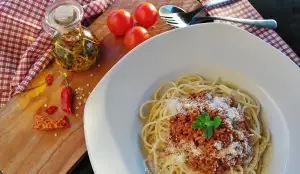Deliciously Crispy Gluten-Free Pizza Crust: A Must-Try Recipe!

Gluten-free pizza crust is a game-changer for those with gluten sensitivities or celiac disease. It allows them to enjoy the deliciousness of pizza without any adverse reactions. But even if you don't have dietary restrictions, gluten-free pizza crust is worth a try. It offers a unique and satisfying texture that can rival traditional pizza crusts. In this article, we will explore the benefits of choosing a gluten-free option and provide you with an easy-to-follow recipe for a deliciously crispy gluten-free pizza crust. Get ready to indulge in a guilt-free pizza experience!
Benefits of choosing a gluten free option
Choosing a gluten-free option for your pizza crust comes with several benefits. Firstly, it caters to individuals with gluten intolerance or celiac disease, allowing them to enjoy a delicious pizza without any adverse health effects. Secondly, a gluten-free crust can be lighter and easier to digest, making it a great choice for those looking for a healthier alternative. Additionally, opting for gluten-free ingredients can expand your culinary horizons and introduce you to new flavors and textures. So why not give it a try and discover the many benefits of a gluten-free pizza crust?
Ingredients needed for gluten free pizza crust
To make a deliciously crispy gluten-free pizza crust, you will need the following ingredients:
1. Gluten-free flour blend: Look for a pre-made blend that includes a mix of flours like rice flour, tapioca starch, and potato starch. This will give your crust the right texture and structure.
2. Xanthan gum: This ingredient is crucial for binding the dough together since gluten is absent. It acts as a substitute for the elasticity that gluten provides.
3. Yeast: Use active dry yeast to help the dough rise and create a light and airy crust.
4. Warm water: The temperature of the water is important as it activates the yeast. Make sure it's warm but not too hot to avoid killing the yeast.
5. Olive oil: Adding olive oil to the dough will enhance its flavor and contribute to a tender crust.
6. Salt: A pinch of salt brings out the flavors in the dough and balances its taste.
These simple yet essential ingredients are readily available in most grocery stores or specialty shops catering to gluten-free products. With these on hand, you'll be well on your way to creating a delectable gluten-free pizza crust at home!
Step-by-step instructions for making gluten free pizza crust
1. In a large mixing bowl, combine 2 cups of gluten-free flour blend, 1 teaspoon of xanthan gum, and 1 teaspoon of salt.
2. Create a well in the center of the dry ingredients and add 1 tablespoon of olive oil and 1 cup of warm water.
3. Using a wooden spoon or your hands, mix the ingredients until they come together to form a sticky dough.
4. Sprinkle some additional flour on a clean surface and transfer the dough onto it. Knead the dough for about 5 minutes until it becomes smooth and elastic.
5. Place the dough back into the mixing bowl, cover it with a damp cloth, and let it rest for 30 minutes to allow the flavors to develop.
6. Preheat your oven to 450°F (230°C) and line a baking sheet with parchment paper.
7. Divide the dough into two equal portions and shape each portion into a round ball.
8. Place one ball of dough onto the prepared baking sheet and flatten it with your hands, shaping it into your desired pizza crust thickness.
9. Repeat this process with the second ball of dough.
10. Once both crusts are shaped, brush them lightly with olive oil to prevent them from drying out during baking.
11. Bake in the preheated oven for about 12-15 minutes or until golden brown around the edges.
12. Remove from the oven and let cool slightly before adding your favorite toppings.
13. Add sauce, cheese, vegetables, meats, or any other toppings you desire.
14. Return the topped pizzas to the oven and bake for an additional 10-12 minutes or until cheese is melted and bubbly.
15. Remove from oven, let cool for a few minutes, then slice and serve hot.
By following these simple steps, you can create a deliciously crispy gluten-free pizza crust that will satisfy your cravings and impress your guests. Enjoy!
Tips for achieving the perfect texture and flavor
To achieve the perfect texture and flavor for your gluten-free pizza crust, here are some tips to keep in mind. Firstly, make sure to use a combination of gluten-free flours such as rice flour, tapioca flour, and potato starch for a well-balanced crust. This will help mimic the elasticity of traditional pizza dough. Secondly, adding xanthan gum or psyllium husk powder can improve the texture and prevent the crust from becoming too crumbly. Additionally, letting the dough rest for at least 30 minutes before rolling it out will allow the flours to hydrate properly and result in a more pliable dough. Lastly, pre-baking the crust for a few minutes before adding toppings will help achieve a crispy texture. Experiment with different ratios of ingredients and baking times to find your preferred taste and consistency.
Variations and toppings for gluten free pizza
Variations and Toppings for Gluten-Free Pizza
One of the best things about making your own gluten-free pizza crust is that you have complete control over the toppings and flavors. Get creative and experiment with different combinations to find your perfect pizza.
For a classic Margherita, top your crust with fresh tomato sauce, mozzarella cheese, and a sprinkle of basil leaves. Add some sliced tomatoes for an extra burst of flavor.
If you're in the mood for something spicy, try a Mexican-inspired pizza. Top your crust with salsa, black beans, corn, jalapenos, and cheddar cheese. Finish it off with a dollop of sour cream and some fresh cilantro.
For a Mediterranean twist, spread hummus on your crust instead of tomato sauce. Top it with roasted red peppers, artichoke hearts, olives, feta cheese, and a drizzle of olive oil.
If you're feeling adventurous, go for a gourmet pizza. Try topping your crust with caramelized onions, goat cheese, prosciutto slices, arugula leaves, and a balsamic glaze drizzle.
Don't forget to experiment with different cheeses like gorgonzola or fontina for unique flavor profiles. And don't be afraid to add some unconventional toppings like figs or truffle oil for an extra touch of luxury.
The possibilities are endless when it comes to gluten-free pizza toppings. Let your taste buds guide you and have fun creating delicious combinations that suit your preferences.
Serving suggestions and pairing options
When it comes to serving gluten-free pizza crust, the options are endless. You can keep it simple and serve it with classic toppings like tomato sauce, cheese, and fresh basil. Or you can get creative and experiment with different flavors and combinations.
For a gourmet twist, try topping your gluten-free pizza crust with caramelized onions, goat cheese, and arugula. The sweetness of the onions pairs perfectly with the tanginess of the goat cheese, while the peppery arugula adds a refreshing bite.
If you're in the mood for something spicy, consider adding sliced jalapenos, pepperoni, and a drizzle of hot sauce. The heat from the jalapenos combined with the salty pepperoni creates a flavor explosion that will leave your taste buds tingling.
For those who prefer a lighter option, top your gluten-free pizza crust with grilled vegetables like zucchini, bell peppers, and eggplant. Add some crumbled feta cheese and a sprinkle of fresh herbs for an extra burst of flavor.
Pairing options for gluten-free pizza are also plentiful. A crisp white wine like Sauvignon Blanc or Pinot Grigio complements the freshness of the toppings. If you prefer beer, go for a light and hoppy IPA to balance out the richness of the crust.
In conclusion, serving gluten-free pizza crust opens up a world of possibilities. Whether you stick to traditional toppings or venture into new flavor combinations, this deliciously crispy crust is sure to satisfy your cravings. So go ahead and give it a try – you won't be disappointed!
In conclusion, gluten-free pizza crust offers a deliciously crispy alternative for those with dietary restrictions or simply looking to explore new flavors. By using a combination of gluten-free flours and carefully selected ingredients, you can create a crust that is both flavorful and satisfying. Whether you have celiac disease or are just trying to reduce your gluten intake, this recipe allows you to enjoy the taste of pizza without any compromise. So go ahead and give it a try – your taste buds will thank you!
Published: 19. 12. 2023
Category: Recipes



